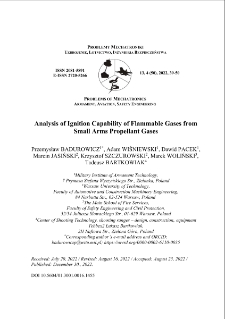Our Digital Library contains 1 868 digital objects
Object
Title: Analysis of Ignition Capability of Flammable Gases from Small Arms Propellant Gases
Alternative title:
Analiza możliwości zapłonu gazów łatwopalnych od gazów prochowych broni strzeleckiej
Contributor:
Abstract:
The article presents the results of tests on the temperature of propellant gases shortly after the bullet leaves the barrel. The temperature and movement of these gases were recorded with thermal cameras and a high-speed camera. Weapons with and without muzzle devices (flash suppressor, silencer) were used. The aim of the research was to check the capability to ignite flammable gases located in the vicinity of the propellant gases produced during firing. Comparison of the maximum temperature of the propellant gases and the ignition temperature of the flammable gases makes it possible to determine the probability of fire. The lowest temperature of propellant gases was in the case of shooting with 9 × 19 mm bullets with the lowest kinetic energy (518 J), and the highest temperature of these gases was during shooting with 5.56 × 45 mm HC (SS109) bullets with the highest kinetic energy (1,785 J).
Place of publishing:
Warszawa
Publisher:
Date created:
Date submitted:
Date accepted:
Date issued:
Extent:
Identifier:
oai:ribes-88.man.poznan.pl:2654
Call number:
Electronic ISSN:
Print ISSN:
Language:
License:
Rights holder:
Starting page:
Ending page:
Volume:
Keywords:
mechanics, small arms, transitional ballistics, propellant gases, thermal camera
Object collections:
Last modified:
Oct 13, 2025
In our library since:
Oct 13, 2025
Number of object content hits:
0
All available object's versions:
https://ribes-88.man.poznan.pl/publication/2983
Show description in RDF format:
Show description in OAI-PMH format:
| Edition name | Date |
|---|---|
| Analysis of Ignition Capability of Flammable Gases from Small Arms Propellant Gases | Oct 13, 2025 |
Objects Similar
Przemysław BADUROWICZ Wiesław STĘPNIAK, Mirosław ZAHOR
Przemysław BADUROWICZ Przemysław KUPIDURA,Wiesław STĘPNIAK, Bartosz FIKUS
Przemysław BADUROWICZ Przemysław KUPIDURA, Bartosz FIKUS

